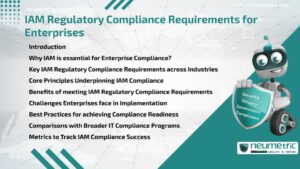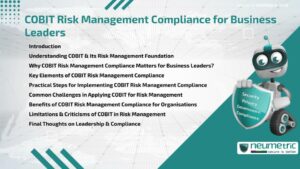Table of Contents
ToggleIntroduction
Risk Management has become one of the most critical responsibilities of business leaders. With increased regulatory scrutiny & complex global operations, Organisations must adopt structured frameworks that align Governance, Compliance & strategic Objectives. COBIT [Control Objectives for Information & Related Technology] offers a proven approach to managing Risks. By following COBIT Risk Management Compliance, business leaders can ensure consistent oversight, reduce Risks & strengthen Organisational resilience.
Understanding COBIT & Its Risk Management Foundation
COBIT, developed by ISACA, is an internationally recognised Framework for Governance & Management of enterprise IT. While it covers a broad spectrum of IT Governance, Risk Management forms a core component.
Unlike standalone Risk frameworks, COBIT integrates Risk with strategic & operational goals. It ensures that Risk practices are not isolated but embedded into daily operations.
Why COBIT Risk Management Compliance Matters for Business Leaders?
Business leaders face mounting pressure to demonstrate Accountability in Risk oversight. Regulations such as SOX [Sarbanes-Oxley Act], GDPR & industry-specific rules require businesses to implement robust Compliance Practices.
By embracing COBIT Risk Management Compliance, leaders can:
- Establish Transparent Governance Structures.
- Ensure Risks are identified, assessed & managed consistently.
- Demonstrate Accountability to Regulators & Stakeholders.
- Enhance decision-making through structured Risk data.
For leaders, COBIT is not just about Compliance-it is about building trust & enabling strategic growth.
Key Elements of COBIT Risk Management Compliance
The Framework defines several components that guide Risk Management:
- Risk Identification – Detect internal & external Risks to Business Operations.
- Risk Assessment – Evaluate the Likelihood & Impact of identified Risks.
- Control Objectives – Define specific goals & safeguards to mitigate Risks.
- Performance Metrics – Monitor progress & Compliance with set benchmarks.
- Maturity Models – Assess organisational Risk practices & plan improvements.
These elements work together to form a structured Compliance model for global enterprises.
Practical Steps for Implementing COBIT Risk Management Compliance
Business leaders can follow these steps to apply COBIT Risk Management Compliance effectively:
- Align with Business Strategy – Ensure Risk practices connect directly with organisational goals.
- Build a Governance Structure – Define roles & responsibilities for Risk ownership.
- Develop Risk Policies – Document procedures & communicate them across departments.
- Leverage Technology – Use automation & analytics tools for monitoring & reporting.
- Conduct Training – Educate staff & executives on Compliance responsibilities.
- Review Regularly – Evaluate the Framework’s effectiveness & adapt to new Risks.
Common Challenges in Applying COBIT for Risk Management
While valuable, COBIT adoption is not without obstacles:
- Complexity – The Framework can be overwhelming for smaller Organisations.
- Customisation Needs – COBIT must often be adapted to fit specific industries.
- Cultural Resistance – Shifting leadership & staff mindsets to embrace structured Governance can be difficult.
- High Costs – Implementing COBIT at scale involves training & technology investments.
Benefits of COBIT Risk Management Compliance for Organisations
Despite challenges, the benefits are significant:
- Enhanced Regulatory Compliance with Global Standards.
- Stronger decision-making through structured Risk insights.
- Operational resilience in managing Disruptions & Threats.
- Increased Trust from Stakeholders & Regulators.
- Standardisation across global business units.
For leaders, these benefits translate into sustainable growth & competitive advantage.
Limitations & Criticisms of COBIT in Risk Management
COBIT, while effective, has limitations:
- It may not address all industry-specific Risks without customisation.
- Implementation can be resource-intensive.
- Regular updates are required to stay aligned with evolving regulations.
- Some critics argue that COBIT focuses more on IT Governance than broader enterprise Risks.
The IT Governance website provides useful insights into balancing COBIT with other frameworks such as ISO 31000 or NIST.
Final Thoughts on Leadership & Compliance
COBIT Risk Management Compliance offers business leaders a structured pathway to align Governance, Risk & Compliance. While not without its challenges, the Framework enables Organisations to meet regulatory demands, enhance decision-making & foster trust across Stakeholders. For leaders navigating complex global environments, COBIT serves as both a Compliance Tool & a strategic asset.
Takeaways
- COBIT integrates Governance, Risk & Compliance into one Framework.
- COBIT Risk Management Compliance enables leaders to demonstrate Accountability.
- Key elements include Risk identification, Control objectives & Maturity models.
- Challenges exist but can be addressed with planning & customisation.
- COBIT builds Trust & Operational resilience across global enterprises.
FAQ
What is COBIT Risk Management Compliance?
It is the application of COBIT’s Governance Framework to identify, assess & manage Risks while ensuring Regulatory Compliance.
Why is COBIT important for business leaders?
It helps leaders align IT Governance with business goals while demonstrating Accountability in Risk oversight.
Does COBIT focus only on IT Risks?
No, while COBIT emphasises IT, its Framework extends to broader Governance & enterprise Risks when properly applied.
What are the challenges in adopting COBIT Risk Management Compliance?
Challenges include complexity, high costs, customisation needs & cultural resistance to Governance changes.
Can COBIT be combined with other Risk frameworks?
Yes, COBIT is often combined with ISO 31000, NIST or ITIL to provide a more comprehensive Risk Management approach.
Which industries benefit most from COBIT?
Industries like Finance, Healthcare, Technology & Manufacturing find COBIT particularly valuable due to high regulatory demands.
How often should COBIT Compliance be reviewed?
At least annually or whenever significant regulatory or organisational changes occur.
Need help for Security, Privacy, Governance & VAPT?
Neumetric provides organisations the necessary help to achieve their Cybersecurity, Compliance, Governance, Privacy, Certifications & Pentesting needs.
Organisations & Businesses, specifically those which provide SaaS & AI Solutions in the Fintech, BFSI & other regulated sectors, usually need a Cybersecurity Partner for meeting & maintaining the ongoing Security & Privacy needs & requirements of their Enterprise Clients & Privacy conscious Customers.
SOC 2, ISO 27001, ISO 42001, NIST, HIPAA, HECVAT, EU GDPR are some of the Frameworks that are served by Fusion – a SaaS, multimodular, multitenant, centralised, automated, Cybersecurity & Compliance Management system.
Neumetric also provides Expert Services for technical security which covers VAPT for Web Applications, APIs, iOS & Android Mobile Apps, Security Testing for AWS & other Cloud Environments & Cloud Infrastructure & other similar scopes.
Reach out to us by Email or filling out the Contact Form…





